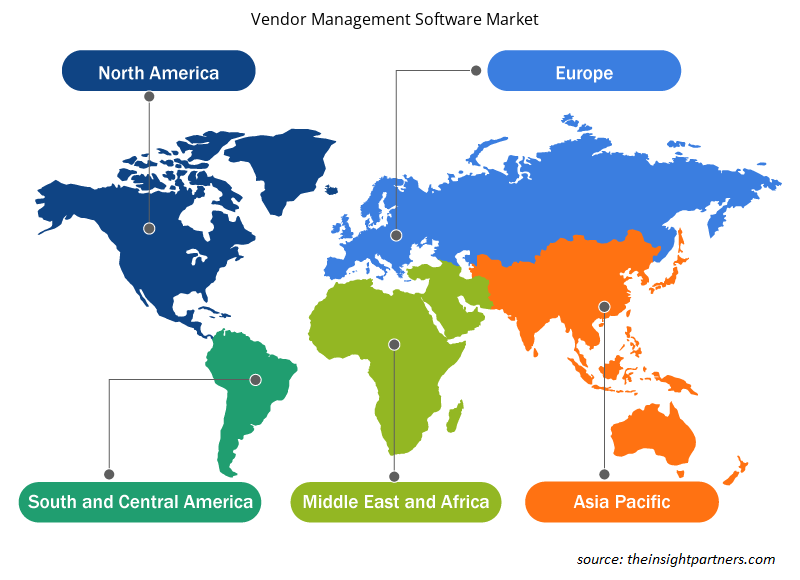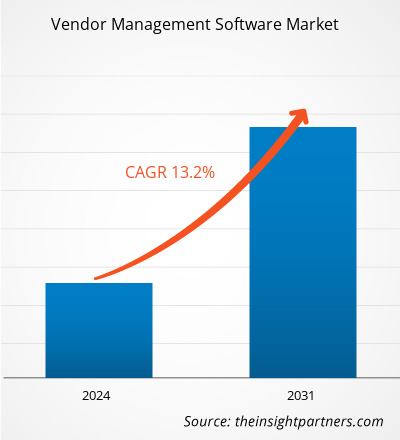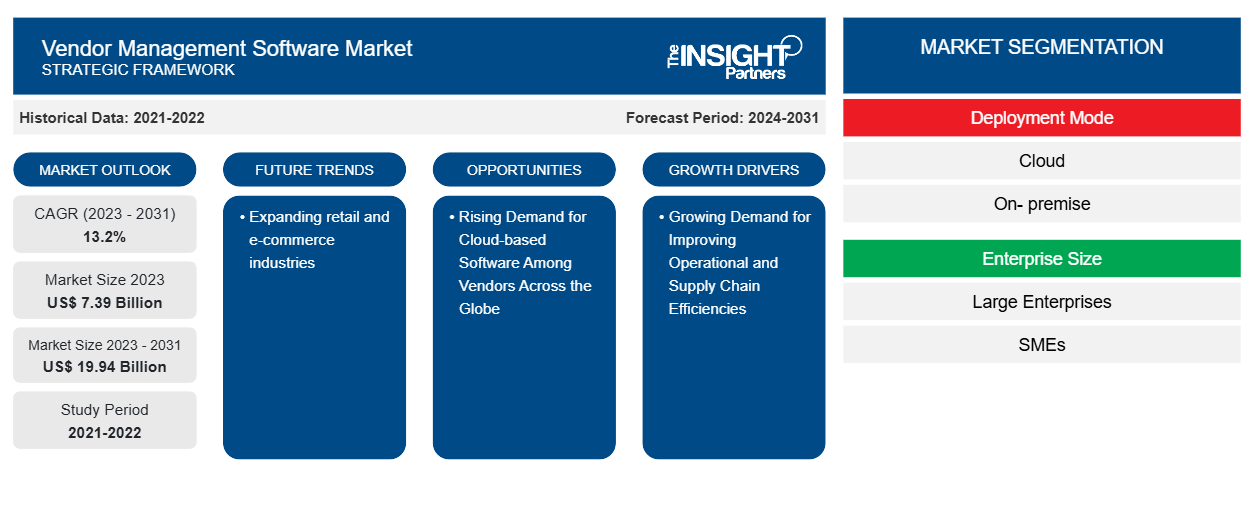Si prevede che la dimensione del mercato del software di gestione dei fornitori raggiungerà i 19,94 miliardi di dollari entro il 2031, rispetto ai 7,39 miliardi di dollari del 2023. Si prevede che il mercato registrerà un CAGR del 13,2% nel 2023-2031. È probabile che l'espansione dei settori della vendita al dettaglio e dell'e-commerce rimanga una tendenza chiave del mercato del software di gestione dei fornitori.
Analisi di mercato del software di gestione dei fornitori
Il mercato del software di gestione dei fornitori sta crescendo a un ritmo rapido a causa della crescente domanda di miglioramento dell'efficienza operativa e della supply chain e delle significative iniziative governative per promuovere lo sviluppo delle PMI con l'adozione del cloud. Il mercato si sta espandendo costantemente, spinto dalla crescente domanda di software tecnologicamente avanzato e conveniente tra i fornitori. Inoltre, la crescente domanda di software basato su cloud tra i fornitori in tutto il mondo e le crescenti complessità nella gestione delle relazioni con molti fornitori stanno offrendo opportunità redditizie per la crescita del mercato.
Panoramica del mercato del software di gestione dei fornitori
La gestione dei fornitori consiste nello sviluppo e nel mantenimento di relazioni con i fornitori di beni e servizi necessari per le operazioni quotidiane. Il software di gestione dei fornitori è un'applicazione software utilizzata dai fornitori per gestire in modo appropriato la loro supply chain o le reti di distribuzione. La crescente necessità di ridurre i rischi e prendere decisioni più rapide da parte delle aziende sta creando opportunità di crescita per il mercato del software di gestione dei fornitori.
Personalizza questo report in base alle tue esigenze
Riceverai la personalizzazione gratuita di qualsiasi report, comprese parti di questo report, o analisi a livello nazionale, pacchetto dati Excel, oltre a usufruire di grandi offerte e sconti per start-up e università
-
Scopri le principali tendenze di mercato in questo rapporto.Questo campione GRATUITO includerà analisi di dati che spaziano dalle tendenze di mercato alle stime e alle previsioni.
Driver e opportunità di mercato per il software di gestione dei fornitori
La crescente domanda di miglioramento dell'efficienza operativa e della catena di fornitura sta guidando il mercato
La crescente adozione di software ad alta tecnologia in diverse aziende per ottimizzare i processi aziendali sta guidando l'installazione di sistemi di gestione dei fornitori. Le organizzazioni si stanno concentrando sempre di più sull'automazione dei loro processi aziendali per ottenere maggiori efficienze a costi inferiori, il che aumenta la domanda di software di gestione dei fornitori per ottimizzare i processi aziendali. Il software di gestione dei fornitori viene utilizzato per gestire le informazioni relative ai fornitori e le operazioni organizzative al fine di ottenere una crescita a lungo termine in modo efficace. L'implementazione del software di gestione dei fornitori consente alle organizzazioni di adottare misure appropriate per ridurre i potenziali rischi dei fornitori, regolare i costi, ottenere valore dai fornitori e garantire un'eccezionale fornitura di servizi a lungo termine, il che dovrebbe guidare il mercato durante il periodo di previsione.
Crescente domanda di software basato su cloud tra i fornitori in tutto il mondo: un'opportunità nel mercato del software di gestione dei fornitori
La crescente domanda di software di gestione dei fornitori basato su cloud tra i fornitori in tutto il mondo sta creando opportunità sul mercato. Il software di gestione dei fornitori basato su cloud offre vantaggi significativi all'utente, come scalabilità, convenienza e accessibilità, fornendo ai fornitori maggiore flessibilità nell'integrazione con i sistemi attuali, gestendo fornitori distribuiti geograficamente e ridimensionando rapidamente le risorse per soddisfare la domanda fluttuante. Inoltre, gli investimenti governativi favorevoli per promuovere l'adozione di software basato su cloud stanno creando opportunità sul mercato. Ad esempio, il Dipartimento della Difesa degli Stati Uniti ha investito circa 38,6 miliardi di dollari in IT non classificato nell'anno fiscale 2022. L'Office of Management and Budget (OMB) ha incaricato le agenzie di modernizzare, eliminare gradualmente o unire i loro portafogli di programmi software al fine di promuovere l'utilizzo del cloud. Ciò aumenta la domanda di soluzioni basate su cloud tra i clienti. Pertanto, creando opportunità sul mercato durante il periodo di previsione.
Analisi della segmentazione del rapporto di mercato del software di gestione dei fornitori
I segmenti chiave che hanno contribuito alla derivazione dell'analisi di mercato del software di gestione dei fornitori sono la modalità di distribuzione, le dimensioni dell'azienda e il settore verticale.
- In base alla modalità di distribuzione, il mercato del software di gestione dei fornitori è suddiviso in cloud e on-premise. Il segmento cloud ha detenuto una quota di mercato maggiore nel 2023.
- Sulla base delle dimensioni aziendali, il mercato è diviso in grandi imprese e PMI. Il segmento delle grandi imprese ha detenuto una quota di mercato maggiore nel 2023.
- In termini di settore verticale, il mercato del software di gestione dei fornitori è classificato come vendita al dettaglio, produzione, BFSI, IT e telecomunicazioni e altri. Il segmento della vendita al dettaglio ha detenuto una quota di mercato maggiore nel 2023.
Analisi della quota di mercato del software di gestione dei fornitori per area geografica
L'ambito geografico del rapporto di mercato sul software di gestione dei fornitori è suddiviso principalmente in cinque regioni: Nord America, Asia Pacifico, Europa, Medio Oriente e Africa e Sud America/Sud e Centro America.
In termini di fatturato, il mercato del Nord America ha rappresentato la quota di mercato più grande del software di gestione dei fornitori, a causa della crescente necessità di una gestione efficace ed efficiente dell'intero canale di distribuzione. Importanti iniziative e investimenti governativi per lo sviluppo delle PMI stanno guidando il mercato durante il periodo di previsione. Ad esempio, nell'agosto 2022, il Dipartimento del Tesoro degli Stati Uniti ha autorizzato un ulteriore lotto di quattro offerte statali investendo 750 milioni di dollari USA attraverso la State Small Business Credit Initiative. Il Tesoro ha annunciato approvazioni di finanziamenti per un totale di oltre 2,25 miliardi di dollari USA per stimolare la crescita delle piccole imprese. Tuttavia, le iniziative governative per promuovere le PMI verso l'adozione di software e soluzioni avanzati per migliorare la loro rete di distribuzione stanno stimolando il mercato.
Approfondimenti regionali sul mercato del software di gestione dei fornitori
Le tendenze regionali e i fattori che influenzano il Vendor Management Software Market durante il periodo di previsione sono stati ampiamente spiegati dagli analisti di Insight Partners. Questa sezione discute anche i segmenti e la geografia del Vendor Management Software Market in Nord America, Europa, Asia Pacifico, Medio Oriente e Africa e Sud e Centro America.

- Ottieni i dati specifici regionali per il mercato del software di gestione dei fornitori
Ambito del rapporto di mercato sul software di gestione dei fornitori
| Attributo del report | Dettagli |
|---|---|
| Dimensioni del mercato nel 2023 | 7,39 miliardi di dollari USA |
| Dimensioni del mercato entro il 2031 | 19,94 miliardi di dollari USA |
| CAGR globale (2023-2031) | 13,2% |
| Dati storici | 2021-2022 |
| Periodo di previsione | 2024-2031 |
| Segmenti coperti |
Per modalità di distribuzione
|
| Regioni e Paesi coperti |
America del Nord
|
| Leader di mercato e profili aziendali chiave |
|
Densità dei player del mercato del software di gestione dei fornitori: comprendere il suo impatto sulle dinamiche aziendali
Il mercato del software di gestione dei fornitori sta crescendo rapidamente, spinto dalla crescente domanda degli utenti finali dovuta a fattori quali l'evoluzione delle preferenze dei consumatori, i progressi tecnologici e una maggiore consapevolezza dei vantaggi del prodotto. Con l'aumento della domanda, le aziende stanno ampliando le loro offerte, innovando per soddisfare le esigenze dei consumatori e capitalizzando sulle tendenze emergenti, il che alimenta ulteriormente la crescita del mercato.
La densità degli operatori di mercato si riferisce alla distribuzione di aziende o società che operano in un particolare mercato o settore. Indica quanti concorrenti (operatori di mercato) sono presenti in un dato spazio di mercato in relazione alle sue dimensioni o al valore di mercato totale.
Le principali aziende che operano nel mercato del software di gestione dei fornitori sono:
- Società di software Coupa Inc.
- Custode (Cinergy Technology Limited)
- Soluzioni HICX Ltd.
- Società IBM
- Società per azioni Intelex Technologies Inc.
- LogicManager, Inc.
Disclaimer : le aziende elencate sopra non sono classificate secondo un ordine particolare.

- Ottieni una panoramica dei principali attori del mercato del software di gestione dei fornitori
Notizie di mercato e sviluppi recenti del software di gestione dei fornitori
Il mercato del software di gestione dei fornitori viene valutato raccogliendo dati qualitativi e quantitativi dopo la ricerca primaria e secondaria, che include importanti pubblicazioni aziendali, dati associativi e database. Di seguito è riportato un elenco degli sviluppi nel mercato del software e delle strategie di gestione dei fornitori:
- A novembre 2022, Cloud5 Communications, Inc ha lanciato una nuova soluzione di Project Management per gestire l'intero ciclo di vita delle relazioni di progetto, dalle negoziazioni contrattuali e dalla gestione quotidiana all'escalation e alla risoluzione dei problemi. Il PMO di Cloud5 funge da risorsa unica per tutte le interazioni con i fornitori, creando relazioni solide con i fornitori che possono portare a tariffe migliori, risparmi sui costi e una drastica riduzione del carico di lavoro del personale dell'hotel. (Fonte: Cloud5 Communications, Inc, comunicato stampa, 2022)
Copertura e risultati del rapporto di mercato sul software di gestione dei fornitori
Il rapporto "Dimensioni e previsioni del mercato del software di gestione dei fornitori (2021-2031)" fornisce un'analisi dettagliata del mercato che copre le seguenti aree:
- Dimensioni e previsioni del mercato a livello globale, regionale e nazionale per tutti i segmenti di mercato chiave coperti dall'ambito
- Dinamiche di mercato come fattori trainanti, vincoli e opportunità chiave
- Principali tendenze future
- Analisi dettagliata delle cinque forze PEST/Porter e SWOT
- Analisi di mercato globale e regionale che copre le principali tendenze di mercato, i principali attori, le normative e gli sviluppi recenti del mercato
- Analisi del panorama industriale e della concorrenza che copre la concentrazione del mercato, l'analisi della mappa di calore, i principali attori e gli sviluppi recenti
- Profili aziendali dettagliati
- Analisi storica (2 anni), anno base, previsione (7 anni) con CAGR
- Analisi PEST e SWOT
- Valore/volume delle dimensioni del mercato - Globale, Regionale, Nazionale
- Industria e panorama competitivo
- Set di dati Excel
Report recenti
Rapporti correlati
Testimonianze
Motivo dell'acquisto
- Processo decisionale informato
- Comprensione delle dinamiche di mercato
- Analisi competitiva
- Analisi dei clienti
- Previsioni di mercato
- Mitigazione del rischio
- Pianificazione strategica
- Giustificazione degli investimenti
- Identificazione dei mercati emergenti
- Miglioramento delle strategie di marketing
- Aumento dell'efficienza operativa
- Allineamento alle tendenze normative























 Ottieni un campione gratuito per - Mercato del software di gestione dei fornitori
Ottieni un campione gratuito per - Mercato del software di gestione dei fornitori